Shelves for the kitchen: types, selection and placement
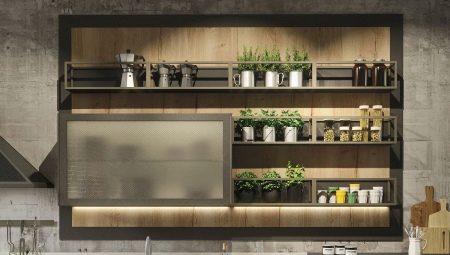
Shelves for the kitchen are purchased in two cases: the first - when there is enough space in the room to install, in addition to the headset, additional furniture; the second - when the room is so small that it makes no sense to burden it with top closed drawers, and open shelves come to the rescue, letting in light and air, preserving the volume of the room.
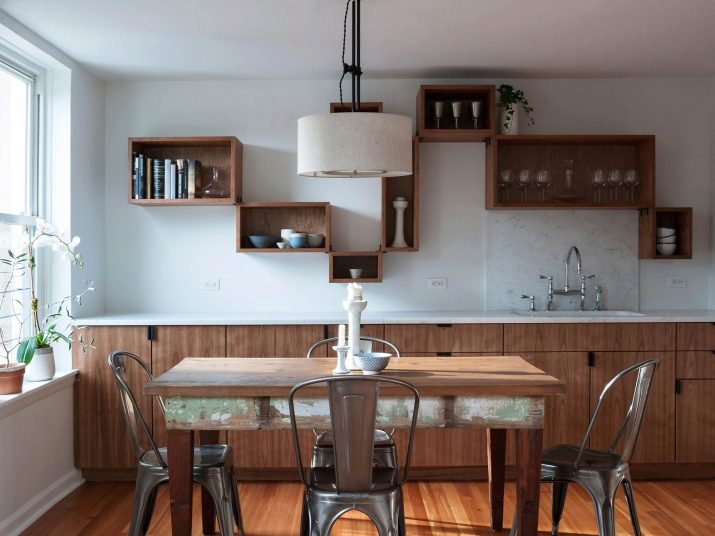

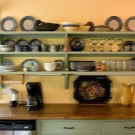
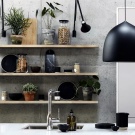
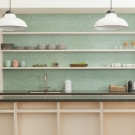
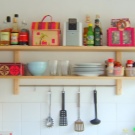
Pros and cons of using
The kitchen is filled with many necessary items, and no matter how many additional storage places are created, they will not be superfluous. For this reason, it seems to many that the shelves in the kitchen can only have merit.
But if you take a closer look at the issue, you can find both pros and cons. Let's take a look at the benefits of kitchen shelves first.
- Open shelves of the upper tier, in contrast to closed cabinets, relieve space.
- Shelves can be decorative or functional. In any case, the benefits of them are obvious.
- An important role is played by the easy accessibility of open shelves, especially if they are located in the work area.
- The presence of shelves allows you to organize things. All items find their permanent place and do not clutter the tables.
- The simplicity of the design makes it possible to make it yourself.
- Corner open products will not create problems with opening the doors, as is the case in ill-conceived headsets.
- Shelves are cheaper than hanging boxes. A large selection and variety of materials, shapes and colors will allow you to choose them for any stylized interior.
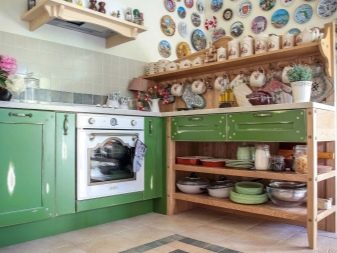
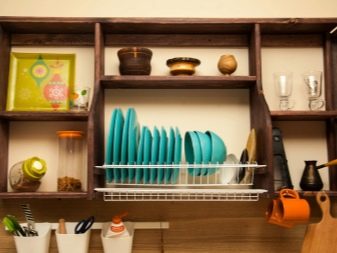
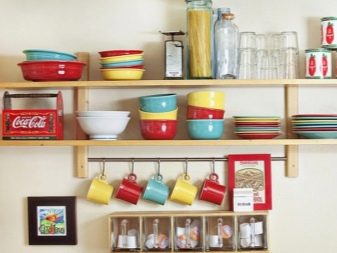
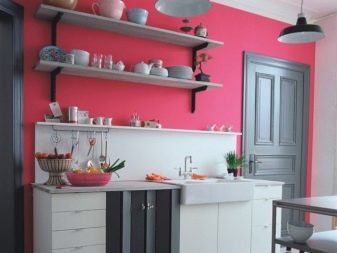
The disadvantages include the following points:
- dust settles on the shelves faster than it happens with closed furniture, respectively, and they will have to be cleaned more often;
- open structures are always in sight, they stimulate the maintenance of perfect order;
- you can't put old utensils on display, which means that not everything that needs additional storage space can count on it.
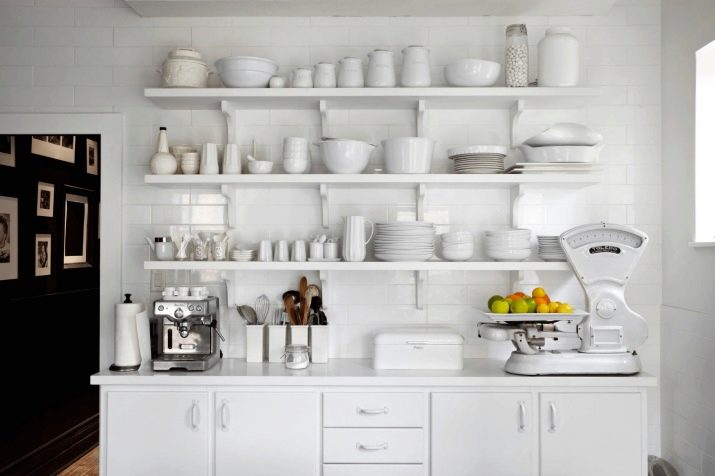
Types of structures
Kitchen shelves can be categorized according to location (floor, table, wall), material, color and shape. The constructive variety of products helps to choose them for any purpose and location, as well as use for many styles.
Kitchen shelves come in many different types.
Open
The models have simple, laconic forms. The absence of doors simplifies installation and allows you to do it yourself. Such shelves can be so beautiful that even when unloaded they become an interior decoration, and if you place decor on them, they will support any style of kitchen. Open shelves can be work-oriented and can withstand household appliances or heavy utensils.
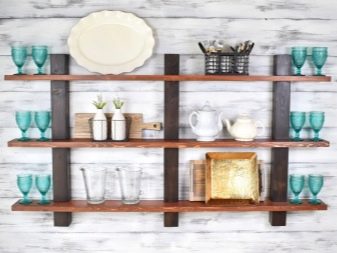
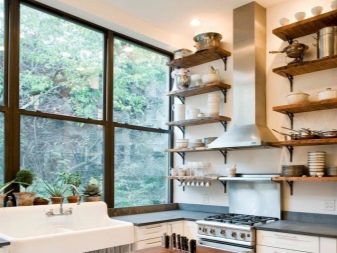

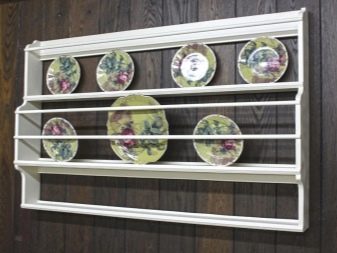
Closed
Sometimes products are equipped with hinged, sliding or lifting doors. Such furniture allows you to hide unsightly, but necessary kitchen utensils from public view.
Closed shelves do not need endless cleaning, tight-fitting doors keep the contents from dust.
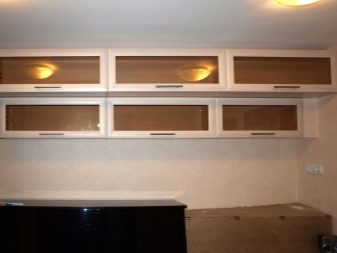
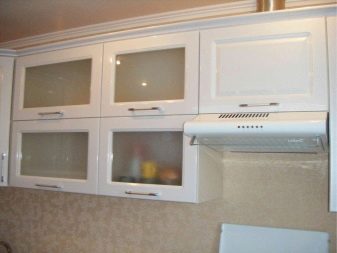
Corner
Such shelves can include from one to several tiers. Corner products are very convenient, especially for small kitchens. They occupy a corner that is unsuitable for other types of furniture. At the same time, the structure looks compact and has good capacity.
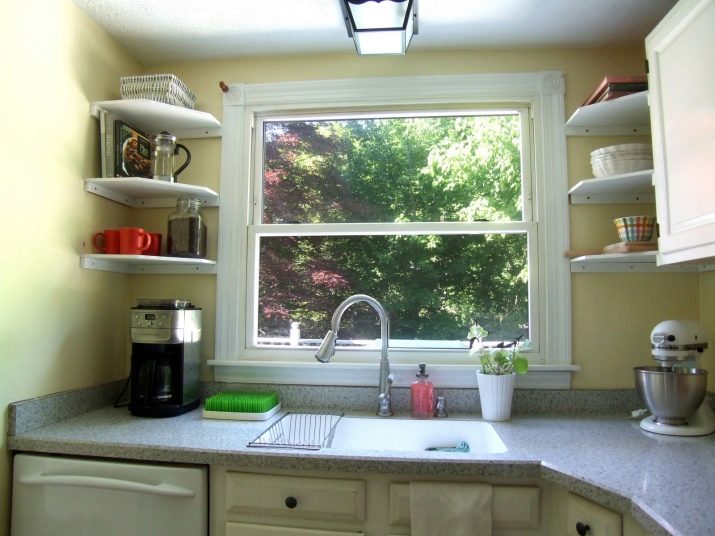
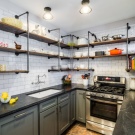
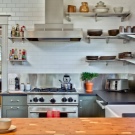


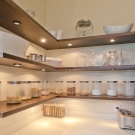
Lattice
Most often they are made from metal. The plane of the shelves looks like an elegant lattice. The chrome-plated versions are located above the sink, they serve as a drying function for plates and cups.
In modern kitchen styles (hi-tech, minimalism, loft) chrome shelves can decorate any corner. Lattice products are also made with forging elements.
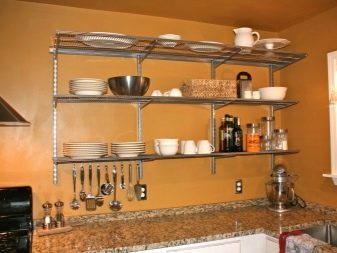
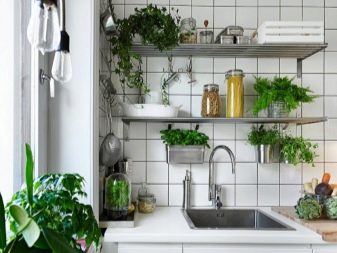
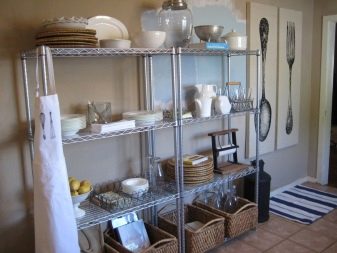
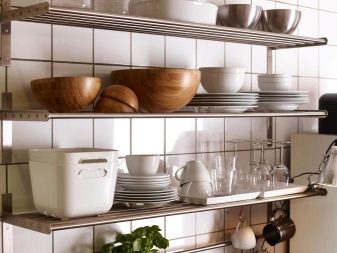
Complicated
Unlike conventional shelves, they can be complicated by the presence of boxes, or have a combined design, in which some sections are endowed with doors, while others remain open.
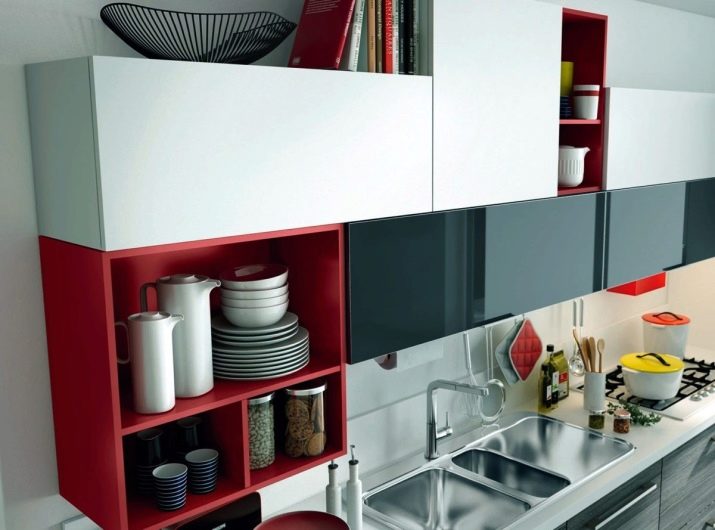
Retractable
They are placed in the lower tier pedestals. The shelves are very conveniently fed, they can slide out, slide out on casters, rotate and protrude from the pedestals. Depending on the location and model of the shelves, they are used for spices, detergents, for cans or bottles.
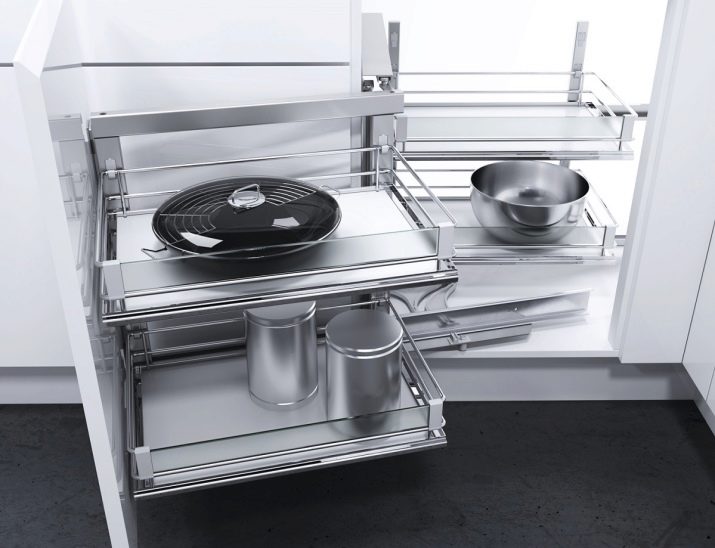
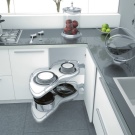
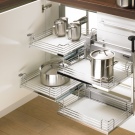
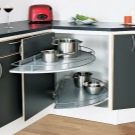
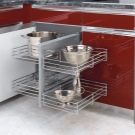
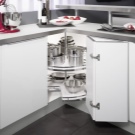
With lighting
Backlighting can make the shelves in the interior accent, draw attention to the decor. If the structure is located in the work area, additional lighting is of practical importance.
It is more convenient to cook on a illuminated countertop or stovetop, and a well-lit sink will allow you to wash the dishes efficiently.

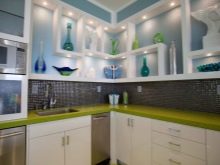
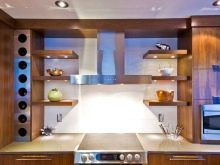
Fancy
For small kitchens, the unusual 4-in-1 shelf is very convenient. This small-sized device contains three roller shelves - for paper towels, cling film and bags, as well as additional storage space for spices and other accessories.
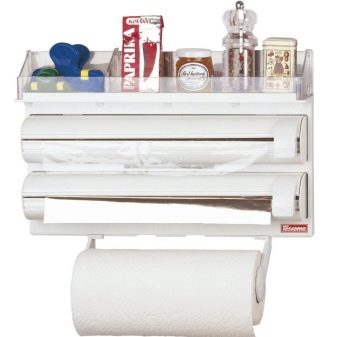
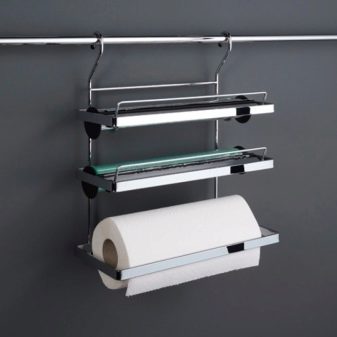
Manufacturing materials
Kitchen shelves have different purposes, they can be filled with light little things or heavy objects - dishes, appliances. Spice shelves are often made of glass, plastic, wooden slats, and wood, chipboard, and metal are chosen for products for kitchen appliances or pots.
Wood
A warm natural material that is great for making furniture. Oak, alder, apple, beech, pine - each species has its own color and unique pattern. The wood is treated with impregnations against insect pests and coated with paints and varnishes, after which it acquires moisture-resistant properties and is suitable for kitchen shelves.
Wood is a versatile material, it is used for the manufacture of products of various configurations and sizes; many design styles, from historical to modern, cannot do without it.
Wood is easily processed, so it is chosen as a material for making shelves with your own hands. Without it, it is impossible to create interiors in the style of country, classicism, empire, baroque, provence, shabby chic. Even modern kitchen finishes, which prefer glass and metal, use natural wood in their design.
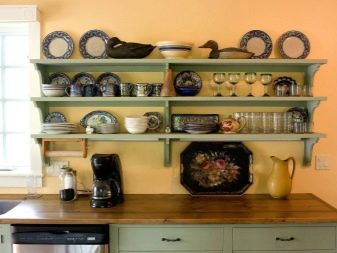

MDF and chipboard
Chipboards are excellent imitators of natural wood. They are covered with veneer of various types of trees, this makes it possible to choose shelves with any palette and pattern, to exactly match the style and color of the decor in a particular kitchen. Considering that chipboard is noticeably cheaper than wood, the availability of such material for every family is obvious.
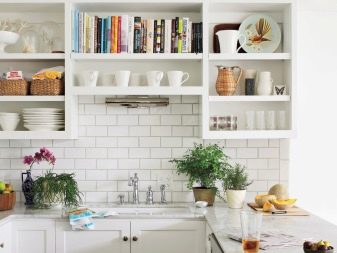
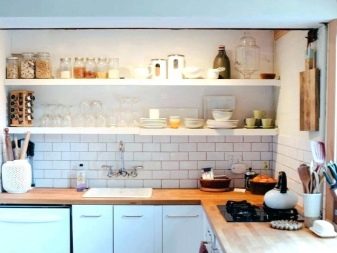
Glass
Glass shelves seem impractical; after wet cleaning, stains remain on them. But, on the other hand, no material will make the shelves so airy and weightless.
Dishes or decor items displayed on them literally float in the air. Glass allows light to pass through, this makes the space seem more voluminous.
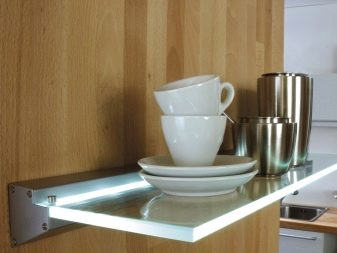
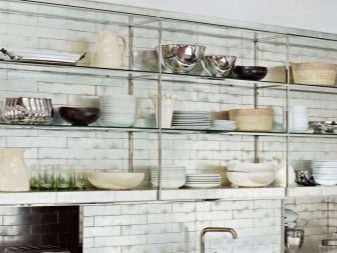
Metal
Metal shelves cannot compete in popularity with wood shelves, but they do have a rich selection. Forged models with attractive openwork patterns are graceful and beautiful. Such products are used in the styles of Gothic, Provence, some types of country. The chrome-plated options are represented by lattice shelves.
Miniature specimens are hung on rails, using for little things, and larger and stronger models are fixed on the wall or installed on tables near the sink, using as a dish dryer. Modern techno styles adorn any wall with chrome shelves. For retro directions, products stylized as copper, bronze or brass are produced.
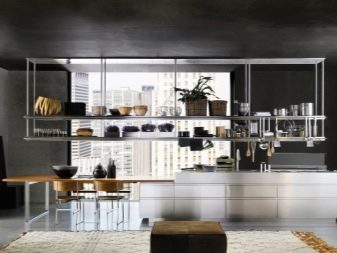

Stone
Shelves made of artificial and natural stone are not often found in the kitchen, although they suit many styles - rustic, historical, ethnic, techno. The stone belongs to expensive and heavy materials. Large floor products are made to order. Miniature shelves made of artificial stone are fixed with a hidden method, they look unusual, as if glued to the wall.
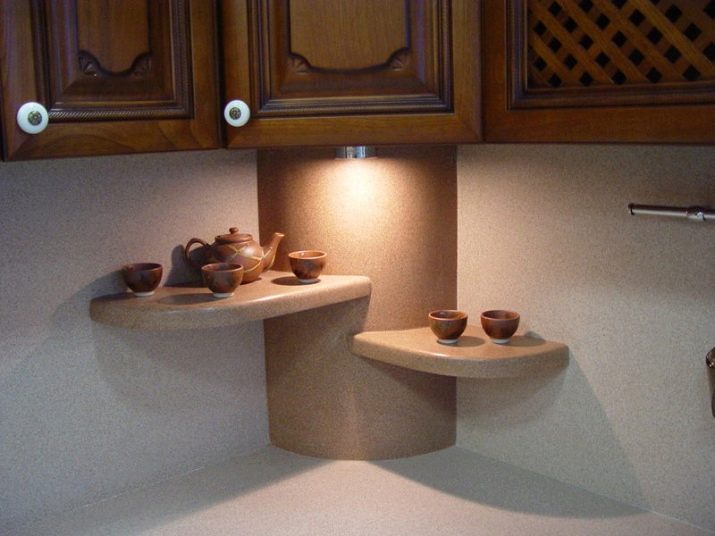
Plastic
In a simple modern kitchen, the plastic surfaces of the shelves will look quite organic. The industry produces durable material of matte and glossy textures, variegated colors, as well as imitation of stone and wood.
Plastic belongs to waterproof materials, it is easy to care for it, and such shelves are cheaper than any other product.
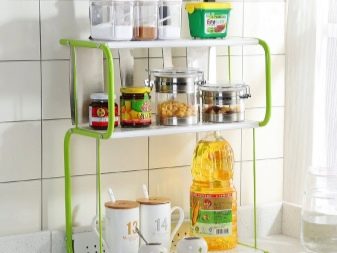
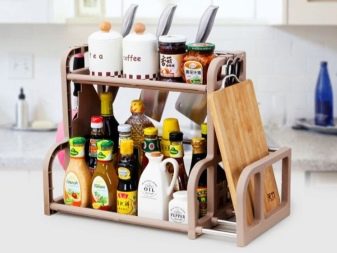
How to choose?
Before choosing shelves for the kitchen, you need to decide for yourself what they will be filled with and where to be. In the first case, you can understand the required volume of the structure, in the second, you can calculate the size.
If the shelves are used for spices or other little things, 1-3-level small structures made of wood, plastic or glass are suitable. Good for small things railing shelves (lattice) on hangers made of chrome-plated metal. For a large number of dishes or for equipment, you should choose solid structures made of reliable material - wood or metal. In this case, corner structures are convenient - they take up little space, but have a large capacity.
If your kitchen has a lot of decor and displayware, light open shelves might be worth considering. For storing pots and pans, massive closed shelves are selected as additional storage places for the headset.
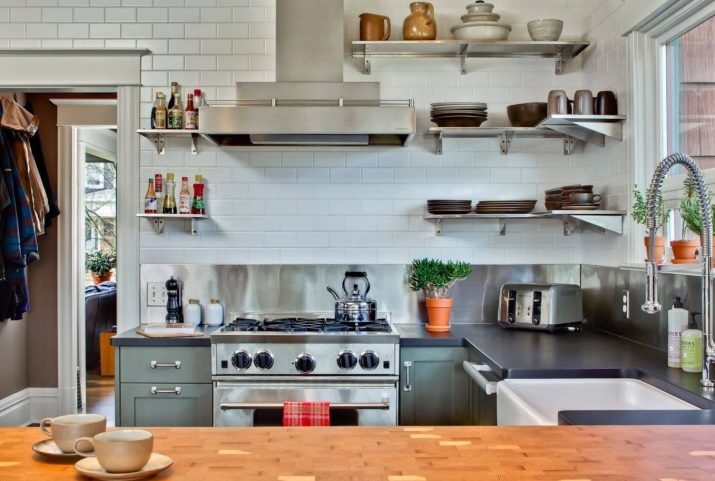
Small attachments are best purchased on hinges, they can be removed and washed. Various options for retractable, retractable and rotating products are convenient, on which all contents have easy access.
In small kitchens, for which every centimeter is registered, and which cannot be cluttered with hanging drawers, they use shallow shelves above the worktop, extending into the ceiling, combined with open and closed sections.
If the family is small, and the question of storage space is not urgent, you can get by with several open shelves, saving space in the room.
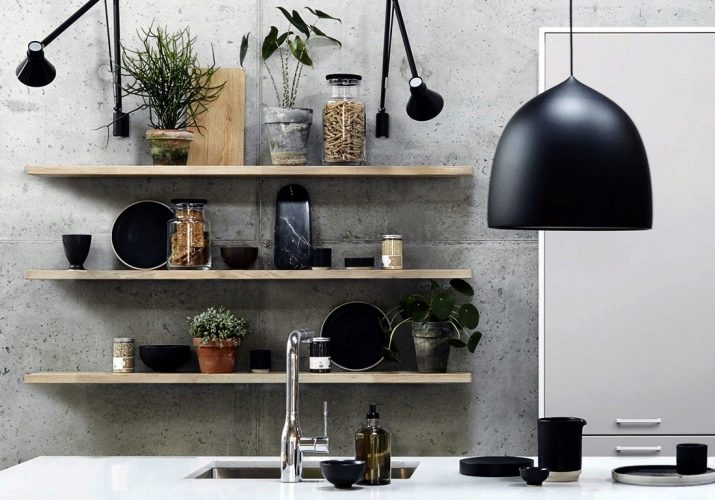
For styles such as minimalism, hi-tech, small glass shelves that let in light and create volume are well suited.
It is important that the purchased products match the style and color of the interior, have a harmonious appearance, and meet the taste of the owners.
How to arrange it correctly?
Shelves are versatile furniture and can be found anywhere. Let's look at examples of different options for the location of the shelves.
- It is convenient to have little things right at hand. To do this, equip an iron, stainless steel, drywall or any other shelf on the desktop. With this arrangement, each object falls into the field of view.
- The window in the working area is surrounded on both sides by shelves for dishes.
- Corner open models are great for small kitchens. With a large capacity, the products take up little space.
- Simple straight-line shelves can completely replace hanging cabinets in the kitchen, taking up the entire wall above the work surface.
- Structures on chains or cables are hung in the center of the kitchen, the hostess gets additional storage space in the most unexpected place.
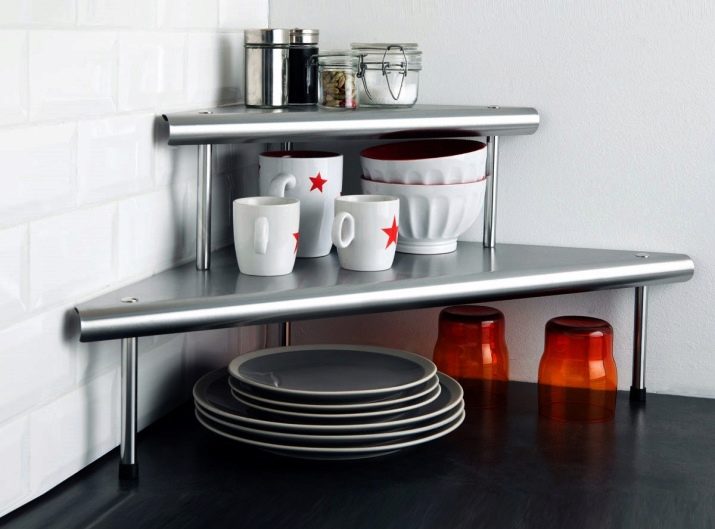
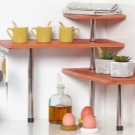
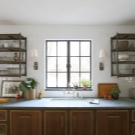
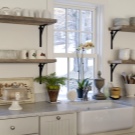
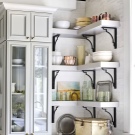
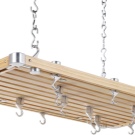
Decorating ideas
In the kitchen they cook, eat, relax, and arrange gatherings with friends. Every hostess wants to see this room cozy and unique. Moments of identity and home warmth will help bring in unusual decoration.
- Original shelves are arranged from simple boxes. You can put any little things on them.
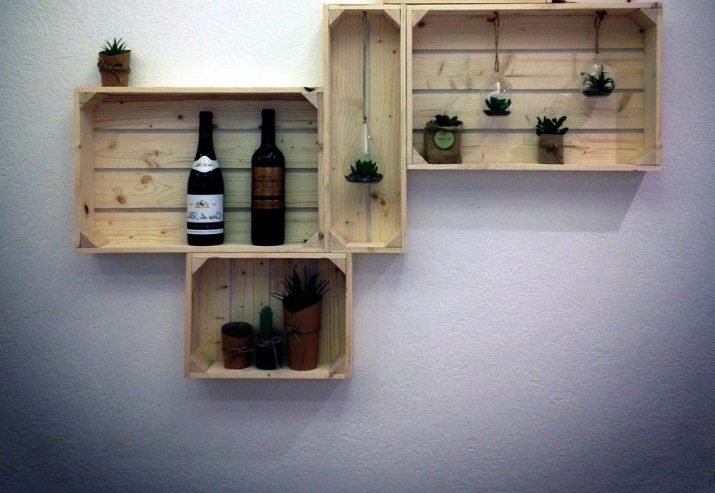
- In Provence or Shabby Chic style, storage spaces on slightly modified staircases look great.
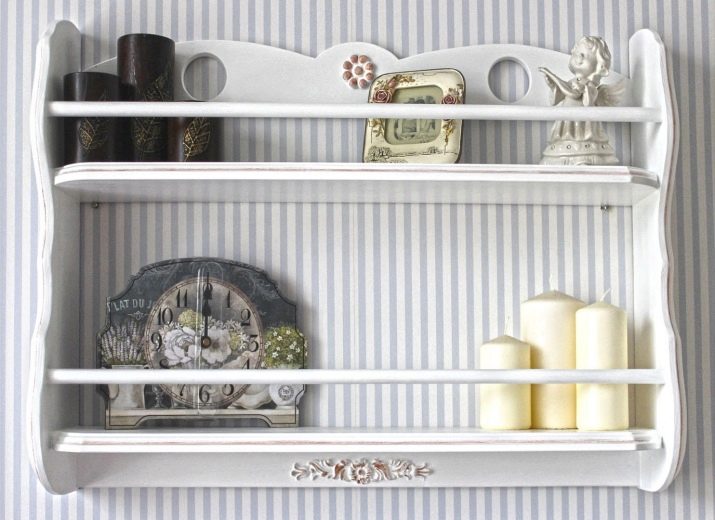
- Vertical wine shelves take up little space in the kitchen, but they collect the entire home wine collection.
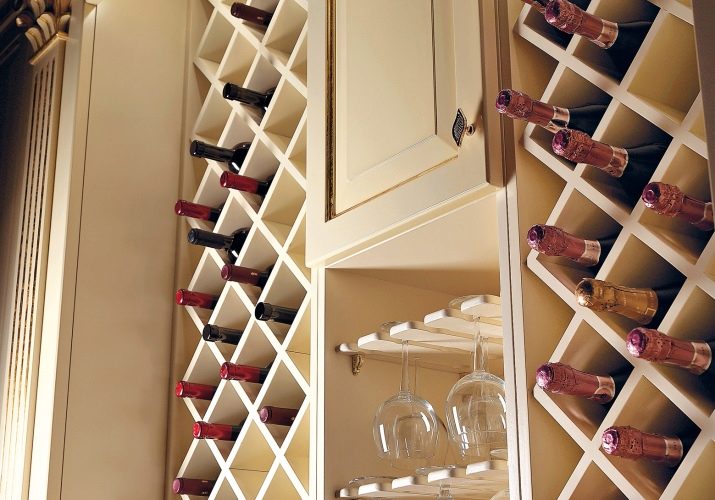
- Glass shelves with white dishes can decorate any wall. With the right illumination, plates and vases seem to float in the air.
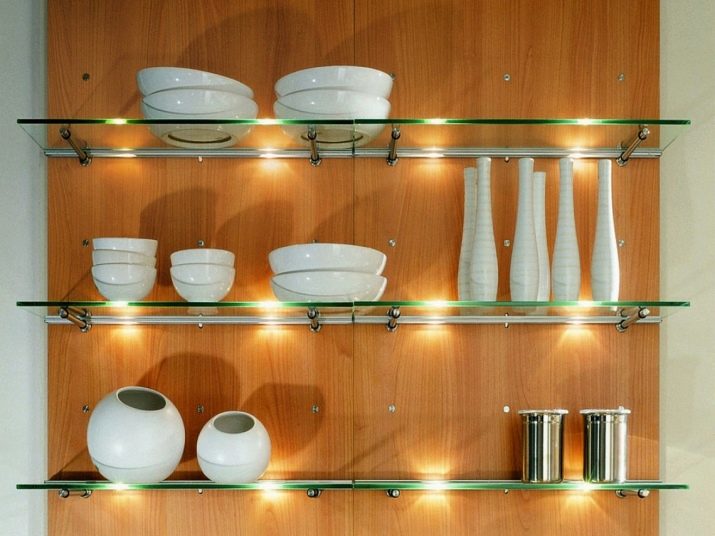
Kitchen shelves are so different that they will always find their purpose. They can store small things, take on the load of household appliances, become a decoration of the kitchen, showing off beautiful dishes and decorative elements.
For information on how to make an unusual do-it-yourself kitchen shelf, see below.








